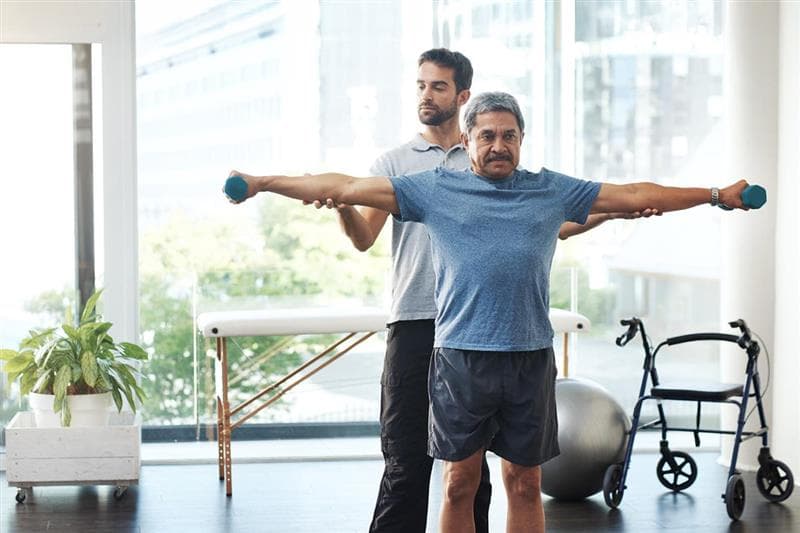
Loading...

Loading...
2025-08-19
Antara
Exercise after surgery is vital to help seniors recover well. Research shows that many older patients lose their ability to perform daily activities after emergency surgery. Only some of the patients return to their previous level of activity. At Antara, we focus not only on medical care but also on physical activities that help them in staying active and engaged. Recovery through rehabilitation becomes a key part of the healing process.

Seniors who do proper rehab exercises after surgery see better results. Most patients recover about 75% of their function by month three. Post-surgery rehab helps blood flow better to injured areas and lowers the risk of new injuries. Patients who follow structured rehab programmes show improved recovery rates.
This article shows you the best rehabilitation exercises for seniors recovering from surgeries of all types. You will also learn about gentle movements, safety tips, and how physical therapists can guide your recovery. Senior patients who face challenges after surgery can take their first step toward independence and mobility by learning these exercises.
Seniors need rehabilitation to recover after surgery. Studies reveal that about one-third of patients over 70 get disabilities in the hospital, which disrupt their usual daily routines. Without proper post-surgery exercises, these older adults deal with significant health risks.
Missing rehabilitation can cause:
Seniors who take part in post-surgery rehab show amazing results. The numbers prove it - rehab exercises lower hospital readmission rates by a lot and boost heart and lung function to prevent complications. Patients who do these exercises report better life quality and feel more satisfied with their care.
The positive effects go beyond physical healing. Rehab programmes help reduce anxiety and depression, which gives patients vital emotional support as they recover.
Older surgical patients benefit from even light exercise after they're admitted. Supervised rehab gives them structure during tough times and helps them become independent again.
Many elderly patients lose some function after surgery. This makes rehabilitation a must-have rather than just an option to recover successfully.
Your recovery starts right after surgery, typically within 24-48 hours. Post-operative exercises are the foundations of this healing experience.
Post-surgery rehab wants to:
Your physiotherapist customises a rehab plan tailored to your surgery. They provide the right techniques and a proper path to progress. Studies reveal that patients recover better when they receive expert supervision. Physiotherapists collaborate with other healthcare experts to coordinate care. They become vital partners in your recovery experience.
At Antara, recovery after surgery means more than doing exercises. It focuses on helping seniors regain their strength, self-confidence, and ability to live in their own time. Each rehabilitation program is tailored to match the patient's specific surgery, health needs, and comfort. Experienced physiotherapists oversee every step to make sure movements are done right and injuries are avoided.
Rehabilitation exercises are the foundation of recovery for seniors after surgery. Most older adults face substantial functional challenges after their operation. These exercises help seniors regain their independence and reduce complications.
The benefits of consistent rehabilitation go way beyond the reach and influence of simple recovery. Seniors who follow well-laid-out exercise programmes experience better blood circulation, less pain, and lower hospital readmission rates. These activities help prevent dangerous complications like blood clots and muscle atrophy.
Each type of surgery needs its own approach. Knee replacements work best with leg raises, while heart surgery patients need gentle breathing exercises. Recovery from hip surgery focuses on careful walking and targeted movements. Every senior needs a personalised plan that addresses their unique recovery trip.
Rehabilitation after surgery gives seniors their best chance to return to normal activities. Full recovery might take time, but post-operative exercises provide physical healing and emotional support during challenging times. Seniors who accept new ideas about rehabilitation become stronger, more confident, and better prepared to enjoy their independence again.
Your rehabilitation programme typically runs for 6–12 weeks, based on your surgery type and personal progress. Your physiotherapist will adjust your routine as you reach recovery milestones.
You can do some exercises at home, but your first instruction should come from your doctor or a physiotherapist. Professional guidance will give you proper technique and help prevent injury.
Skipping rehab puts you at risk of stiffness, delayed healing, and reduced surgical success. Seniors who miss rehabilitation visits face higher chances of returning to the hospital.
The following are some safest post-operative exercises:
Deep breathing exercises
Ankle pumps
Seated leg lifts
Gentle stretching
Slow-paced walking
Take it slow, use support devices when needed, and work with a physiotherapist from the start. A family member's presence during early sessions adds safety and support to your recovery journey.

Please fill in the form and submit the details to request an appointment.